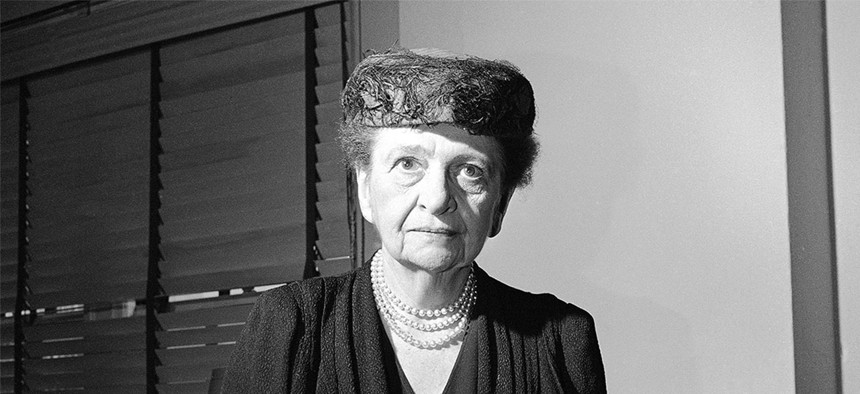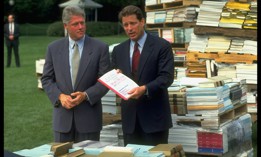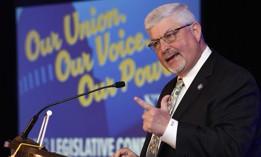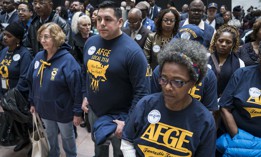Perkins’s vision of America is now in retreat. There are fewer inspectors at the Occupational Safety and Health Administration than ever before, and investigations of workplace fatalities have soared to their highest levels in a decade. Taxi drivers have been driven to financial ruin and suicide, health-care aides work 24-hour shifts, schoolteachers in some states donate plasma and consign their clothes to survive, and undocumented workers live under the threat of deportation. From July through September, a group of Kentucky coal miners camped on railroad tracks, blocking the passage of $1 million worth of coal after their paychecks bounced. no pay we stay declares their sign made from a cardboard box. Our times, as Warren implied in her speech, are not as different from Perkins’s.
In her presidential campaign, Warren is positioning herself not just as an alternative to Donald Trump, but also as a problem-spotter who can change the way Americans think about the reality before their own eyes. Before her election to the Senate in Massachusetts, she led at least two significant shifts in progressive thinking: In the research she undertook as a law professor, she reframed bankruptcy as the result of bad luck amid unfavorable economic conditions, rather than of debtors’ moral failings. Moreover, a basic premise of the Consumer Financial Protection Bureau, whose creation Warren inspired, is that the details of certain mortgage and credit-card loans aren’t just fine print; instead, they conceal sneaky efforts to wrangle money out of consumers. In Wednesday’s debate, former Vice President Joe Biden tried to claim some credit for the bureau, telling Warren, “I went on the floor and got you votes.” Warren instead attributed her legislative victory to an outpouring of popular support for the idea, declaring, “I am deeply grateful to every single person who fought for it and who helped pass it into law.”
Some political handicappers have argued that Warren would be the furthest-left candidate ever elected president. But, like Perkins, Warren is betting that if Americans think hard about injustices that are hidden in plain sight, they’ll demand that Washington take action.
Warren and her team have encouraged the comparison to Perkins. On Twitter, Warren’s chief campaign strategist, Joe Rospars, refers to himself as “a Frances Perkins Democrat.” Warren’s slogan—“Dream big, fight hard”—echoes Perkins’s admonition to Roosevelt when he wavered in his commitment to a public-works program. “He wanted to think it over,” Perkins wrote in her memoirs of her years with Roosevelt. “My heart sank … I felt we must fight hard now.” Woodworkers built the podium from which Warren spoke with boards taken from Perkins’s ancestral home in Maine, on the Damariscotta River, to which Perkins returned all her life. Even Warren’s refrain “I have a plan for that” seems inspired by Perkins. Upon his election as president, Roosevelt was prepared to name Perkins secretary of labor—the first-ever female Cabinet member. She arrived at his Manhattan townhouse with a list of demands—causes she had scribbled on scraps and kept in a drawer, adding up to a list of “practical possibilities.” In other words, Frances Perkins had a plan. She extracted Roosevelt’s commitment to follow it in exchange for her taking a job in his Cabinet.
Perkins never let the president forget her plan, using skills she had honed in the tough world of Tammany Hall and Albany.
Fifty-four years after her death, the broader public is largely unaware of Perkins’s influence, but a number of historians, including Adam Cohen and Kirstin Downey , have chronicled both Perkins’s passion and her influence over Roosevelt. (In recounting key events in Perkins’s life, I have drawn heavily on Cohen’s work and on Perkins’s own writings.)
After the factory fire, Perkins, then about 31, became the executive secretary of New York City’s fledgling Committee on Safety. Her recommendations : fire escapes, exit signs, the nightly emptying of office wastebaskets, sprinkler systems, mandatory fire drills, enclosed stairways, and mandatory unlocked exits that could be used in an emergency within three minutes. Those recommendations and her later ones led to worker-protection laws in New York and across the country. She forced lawmakers to see the horrors of factory life. She took then–New York Governor Al Smith to see thousands of women “coming off the ten-hour night shift on the rope walks in Auburn,” she wrote years later, and she sent then–State Senator Robert Wagner of New York crawling “through the tiny hole in the wall that gave egress to a steep iron ladder covered with ice and ending 12 feet from the ground, which was euphemistically labeled ‘Fire Escape.’”
When Roosevelt succeeded Al Smith as governor of New York, Perkins’s reports satisfied his wish to hear the “human part of the story,” she wrote. “He wanted me to tell them … how we discovered that men were getting silicosis while polishing the inside of glass milk tanks; how the girls painting luminous dials on clock faces and pointing the fine hair brushes with their lips had contracted radium poisoning; how the old carpenter who lost his arm and settled his compensation claim by agreement with his employer without a hearing had been cheated out of about $5,000, which we discovered in a spot check investigation,” Perkins wrote.
After the 1929 crash, Perkins and Roosevelt together took the boldest steps in the country toward unemployment relief: The governor put Perkins in charge of a New York commission that recommended setting up the first unemployment office. From there they drew a road map that, upon Roosevelt’s election as president in 1932, they would later use in the White House to address the Depression and enact the New Deal.
Sworn in as secretary of labor, she found a department rife with cockroaches and corruption. Under Herbert Hoover, the Department of Labor spent some 90 percent of its resources on a Special Immigration Unit, created by the Exclusionary Immigration Acts of 1921 and 1924, which involved two brothers overseeing a team of agents who were sent around the country to find and deport illegal immigrants, with a particular emphasis on alleged communists. Often the agents extorted the immigrants for bribes along the way. Perkins declined to renew the unit’s funding. Over time, she began to radically reorient the department toward the needs of working Americans.
She did not shy away from intramural battles. During Roosevelt’s first 100 days, Perkins prevailed over his budget director and fellow patrician Lewis Williams Douglas, who viewed a balanced budget with an almost religious zeal. “I soon realized that good as Douglas might be in handling the budget, he was expressing, in more agreeable and persuasive terms, the very philosophy against which the country had reacted so violently under Hoover,” Perkins wrote in her memoirs of her years with Roosevelt. When Perkins learned Douglas had thwarted her effort to include billions of dollars for public works in a relief bill, she demanded a morning meeting with Roosevelt.
“You’ve got to decide now, Mr. President,” Perkins insisted, according to Cohen’s account of the meeting. “Here on this beautiful sunshiny afternoon we have to decide if we shall put it in or leave it out.” Roosevelt, always battling conflicting sympathies, agreed, but Perkins took no risks, phoning then–U.S. Senator Robert Wagner, the author of the relief bill and the man Perkins sent crawling down an icy fire escape years earlier, as a witness. Roosevelt took the phone and said, “Frances says that she thinks it’s best and I think it’s the right thing, don’t you, Bob?” Douglas resigned not long after, and Perkins stayed 12 years.
Perkins ably used what leverage she had, and criticism did not deter her. As the New Deal took shape, the Roosevelt administration had significant leverage over corporations, which were seeking relaxation of federal antitrust laws to stall free-falling prices. Perkins thought to phone William Green, president of the American Federation of Labor, and ask which provisions he wanted included in the relief bill. Months earlier, when Perkins’s appointment was announced, Green swore he could “never become reconciled” to the selection of a woman and a nonunion official, in that order. Now he took her call, and asked to include the right to organize nonunion workers in the bill. That provision would eventually be codified and known as the Magna Carta of the labor movement. Ultimately, the only legislation Frances Perkins wanted and didn’t see to fruition was universal health care. But everything else she listed at her meeting in FDR’s townhouse, she got.
The New Deal was an imperfect vehicle that helped some more than others. As Landon Storrs, a historian at the University of Iowa, told me by email, social insurance benefits and minimum-wage protections were tied to occupation at a time when most women and racial minorities worked in occupations excluded from coverage. Many New Deal programs were administered through the states and were therefore subject to local prejudices. And the National Labor Relations Act of 1935 did not immediately benefit minority and female workers as much as others because, like employers, many labor unions in the 1930s discriminated against those groups. But the flaws of the New Deal need not discredit the blueprint of its successes, and its proven political salability.
The New Deal was at best a hope when Roosevelt took office, and nothing about it was inevitable. Only through the vision and dogged advocacy of people like Perkins did the federal government take on greater responsibility for Americans’ welfare in the workplace and in the broader economy. Warren’s veneration of Perkins offers some insight into how the senator sees the current landscape: The United States is a country where workers’ needs are going unaddressed, but also a country that, with the right people in office, is ripe for transformation.













